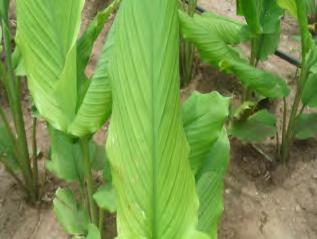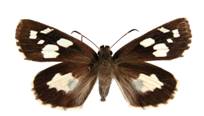Shoot borer: Conogethes punctiferalis
| Symptoms of damage |
- Yellowing and drying of leaves of infested pseudostems.
- The presence of a bore-hole on the pseudostem through which frass is extruded and the withered and yellow central shoot
|
 |
Damaged leaves and larva presence on the inside stem |
|
| Identification of pest |
- Egg: is pink, oval, flat and lays singly or in group on the tender part of the plant
- Larva: is long, pale greenish with a pinkish was dorsally, head and pro-thoracic shield brown in colour and body covered with minute hairs arising on wards.
- Pupa: Pupation takes place in lose silken coccon in larval tunnel.
- Adult: is a medium sized moth, the wings are pale yellowish with black spots on the wings.
|
 |
 |
| Larva |
Adult |
|
| Management |
- Spraying malathion 0.1% at 30 day intervals during July to October is effective in controlling the pest infestation.
- The spraying has to be initiated when the first symptom of pest attack is seen on the inner most leaves on the pseudostem.
|
Rhizome scale: Aspidiella hartii
| Symptoms of damage |
-
Field infestation
- Plants look devitalized, pale and withered before drying completely.
- In such cases at the time of harvest minute yellowish crawlers can be seen moving in large numbers and this is the potential stage of dissemination.
|
|
| Identification of pest |
Storage infestation
- In Initial stage of infestation in, the white coloured scales are seen scattered on rhizomes and latter they congregate near the growing buds.
- When the infestation is severe the rhizome and buds shrivel and ultimately the entire rhizome dries.
Adult
- Female: scales are circular (about 1mm diameter) and light brown to gray and appear as encrustations on the rhizomes.
- Male is orange coloured with transparent wings, distinct head, thorax and abdomen.
|
 |
| Larva |
|
| Management |
- Discard and do not store severely infested rhizomes
- Collect and destroy damaged leaves
- Select healthy rhizomes free from scale infestation for seed materials
- Treat seed material with quinalphos 0.075% (for 20-30 minutes) before storage and also before sowing in case the infestation persists.
- Apply well rotten sheep manure @ 10 t/ ha in two splits or poultry manure in 2 splits followed by drenching dimethoate 30 EC @ 2 ml or phosalone 35 EC @ 2ml /lit of water
|
Leaf roller: Udaspes folus
| Symptoms of damage |
- Leaves become folded or rolled longitudinally
- Complete defoliation
|
 |
| Leaf Spot |
|
| Identification of pest |
- Larva: is smooth green with black head
Adult
- It is brownish black butterfly
- Forewing: has a white spots
- Hind wing: has a large white patch
|
 |
 |
| Larva |
Adult |
|
| Management |
- A spray with carbaryl (0.1%) or dimethoate (0.05%) may be undertaken when the severe infestation
- Spray the following dissolved in 1 lit of water, Bavisitin 2g +Mancozeb 2g + Teefol 1 ml
|
Thrips: Panchaetothrips indicus
| Symptoms of damage |
- Leaves become rolled up
- Turn pale and gradually dry-up
|
| Identification of pest |
- Adult is with fringed wings
|
 |
| Larva |
|
| Management |
- Spray insecticides like quinalphos 0.025% or fenthion or phosalone 0.07%
|
|









